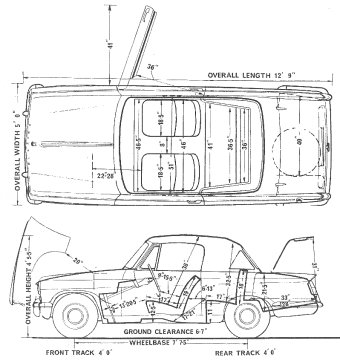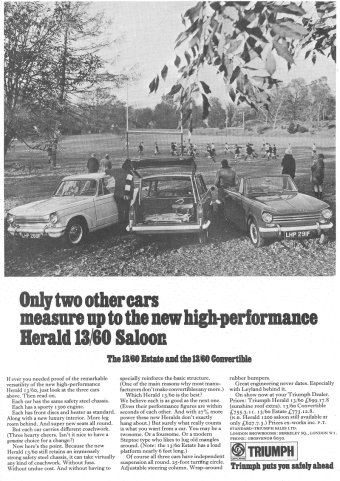The Triumph engineers had developed and updated the Herald almost every year since it's introduction, and with the introduction of the 13/60 in 1968 the little car was in fact very advanced for the time. From 948cc, through 1147cc and finally with the 1296cc engine fitted to the 13/60, performance was at the forefront of each major update.
The new engine allowed the Herald to travel with less effort, and it could cruise comfortably at 70 miles per hour (with a top speed in excess of 80 mph). Acceleration was also vastly improved, although it fell short of allowing spirited driving. 0 - 60 mph
took around 18 seconds, vastly better than the 25.8 seconds it took for the 12/50.
Unfortunately the four speed gearbox, while having well-chosen ratio's, still did not come with synchro in first. There was better news on the braking front, with 9 inch disc brakes being fitted to the front wheels as standard, while the half shafts of the swing-axle independent rear suspension were beefed up.
Because of the diminutive nature of the Herald, the engineers did not bother with fitment of a servo to assist the front discs. With a kerb weight of only 838kg it didn't seem to affect things much, and many road testers of the day claimed the brakes provided a "reassuring and progressive bite".
The steering came in for much praise also, the feel varying with load, being at its neutral best with four people on board. As was the case with other cars that came with a swing-axle suspension set-up, the change of angle of the back wheels was clearly visible; on a heavily loaded Herald there was pronounced lean-in at the top (negative camber). One of the benefits of this was that it widened the rear track and, theoretically, increased stability.
Handling
The handling of the Herald 13/60 remained very much the same as its predecessors, the car requiring particularly hard cornering to make the back end slide - but once you reached the point of no return the back end slid abruptly and unforgivingly.
One up (driver only), the rear wheels carried a slight positive camber, making the oversteer increase if you backed-off mid corner. However in every-day driving the reality was the Herald had better than acceptable road manners, particularly given the steering wheel would get heavier to turn the farther you turned it.
Convertible Driving
By 1968 British convertibles were becoming increasingly rare, particularly if you exclude any kind of sports car. Thankfully the soft-top setup on the Herald was a commendable effort, providing a relatively weatherproof experience when up. Road testers agreed that the 13/60's canvas roof, when up, provided better insulation from not only the elements, but also road noise and draughts.
Naturally a heater was required, particularly for its home market. The single speed unit was effective and provided not only interior heating, but windscreen demisting too.
Given most convertibles are considerably more heavy than their tin-top cousins, the Herald was rather unique in that the convertible was 50lb lighter than the sedan. Scuttle shake was the inevitable result, however this was negligible on any half decent road.
The rear seat accomodation in the convertible differed little from the sedan, meaning the rear leg-room was compromised if the front seats were set all the way back. The hood box took 2 inches off the width, however the seat length was slightly more. The front seats were well made, and could be adjusted for height and angle by raising or lowering the front hinge attachment bolts in the holes provided by turning the off-centre rubber blocks, which formed the rear supports, on their frame tubes.
Cosmetics
Most striking of the new 13/60 Triumph Herald was the Michelotti design of the front.
The most obvious cosmetic change to the 13/60 was the new bonnet, a rigid unit that featured flaired up edges at the sides, creating a somewhat startled eyebrow look. Inside the Herald featured up-market upholstery, moulded carpets that fitted snugly in the foot wells and around the prominent transmission tunnel.
The timber dashboard was classy, with five controls in the centre now being recessed for safety. Triumph adopted the use of a combined wiper/washer knob, while crash padding formed a cowl over the polished wood facia. Directly ahead of the driver were two Smiths dials for speedo, temperature and fuel. Rounded recessed toggles operated the heating, choke, lights and wipers.
Under The Bonnet
Few cars of the era afforded the accessibility to the engine bay as did the Herald. The complete front bonnet, being spring loaded, hinged forward for easy opening. Across the front of the scuttle were the washer reservoir, hydraulic filters, wiper motor, heater unit and battery. Melodious high-pitched twin horns were also standard kit.
|
- Years of Manufacture: 1968 - 1971
- Number Built:
- Saloon: 61,695
- Convertible: 11,772
- Price at Introduction:
- Convertible: £613
- Tax: £142
- Seat Belts: £10
- Tonneau Cover: £9
- Radio: £30
- Chassis/Body:
- Double backbone, seperate body, steel
- Exterior Dimensions 170D:
- Total Length: 12ft 9in.
- Total Width: 5ft 0in.
- Height at kerb weight:
- Wheelbase: 7ft 7.5in.
- Front Track: 4ft 0in.
- Rear Track: 4ft 0in.
- Kerb Weight:
- 1846lb (838kg)
- Front/Rear Weight Distribution:
- Fuel Tank:
- Main: 6.5 gallons (29.5 liters)
- Reserve: 6 pints
- Turning Circle:
- Left: 26ft 5in.
- Right: 26ft 4.5in.
- Instruments:
- Speedometer
- Petrol gauge
- Temp gauge
- Oil pressure warning lamp
- Ignition warning lamp
- Transmission (Manual, Synchromesh to 2nd, 3rd and 4th gear):
- 1st: 3.75:1
- 2nd: 2.16:1
- 3rd: 1.39:1
- 4th: 1.00:1
- Reverse: 3.75:1
- Clutch:
- Borg and Beck, single cushion disc, diaphragm spring 6.5 in. diameter
- Rear Axle Ratio:
- 0-60 mph (0-97 km/h):
- Maximum Speed:
- Engine 4 Cylinder:
- Capacity: 1296cc / 79.2ci
- Type: Watercooled, reciprocating piston type with
4 cylinders
- Configuration: Front mounted, longitudinal,
inline
- Head: Pushrod and rocker actuated ohv
with one valve per cylinder
- Fuel System: A.C. mechanical
- Bore and Stroke: 2.90 x 2.99 inches
(73.7 x 76.0mm)
- Power: 61 bhp @ 5000rpm
- Torque: 73 lb.ft. @ 3000rpm
- Compression Ratio: 8.5:1
- Ignition and Electrical:
- 12 volt 40 Ah
- Lucas C40/1 22-amp d.c.
- Exhaust:
- Suspension:
- Front: Independent, wishbones, coil springs, anti-roll bar, telescopic dampers
- Rear: Independent, swing axles, trailing arms, transverse leaf spring, telescopic dampers
- Steering:
- Type: Alford and Alder Rack and Pinion
- Wheel dia.: 16.0 in.
- Brakes:
- Front: Girling disc, no servo assistance, 9.0in. diameter
- Rear: Drum, 7.0in. diameter, 1.25in. wide shoes
- Swept area:
- Front: 150 sq. in.
- Rear: 55 sq. in.
- Total: 205 sq. in. (198 sq. in./ ton laden)
- Wheels:
- 13" Pressed steel disc wheels
- 4 stud fixing
- 3.5 in. wide rim
- Tyres:
- Dunlop C41 dross-ply tubeless 5.20 x 13

 |
